Colorata’s first dinosaur set doesn’t hold up perfectly to modern science, but overall these are nicely made figures good for both play and display.
There seem to be regrettably few quality dinosaur playsets on the market these days, be it for adult collectors or kids. However, the number is not zero. Japanese company Colorata has produced several sets as part of their larger “Real Figure Box” line. The recent Feathered Dinosaurs set has been covered previously here on the Dinosaur Toy Blog, but let’s take a look at their very first: the Cretaceous set Vol. 1.

There are eight figures included in the set: five dinosaurs and three pterosaurs. The figures come in a carrying case, individually bagged for protection, and all include bases/stands for support. The plastic stands have to be trimmed manually, as they are all equal in length – a minor nuisance. Some figures require minor assembly. The set also includes a bilingual booklet with factoids on each creature. It’s a nice addition, although the booklet doesn’t seem to distinguish the pterosaurs from the dinosaurs – a subtle but possibly problematic oversight.
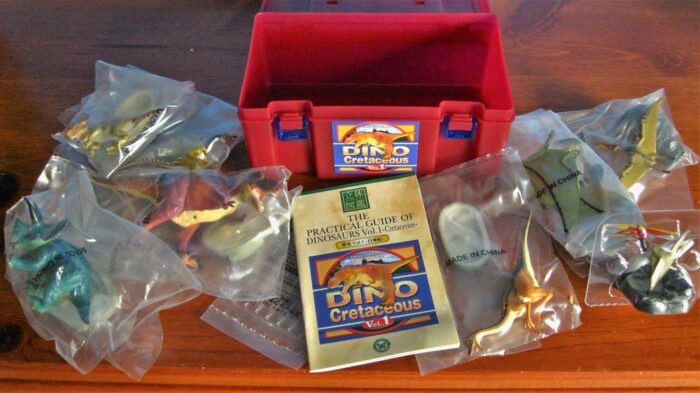
Figure #1 is, unsurprisingly, the iconic Tyrannosaurus rex. At 6″ long and 3″ tall, this is the largest figure in the set, and it has an impressive build despite its still relatively small size. This is a healthy, hefty specimen of a T. rex, with thick musculature all over and not a sign of shrink-wrapping. The skeletal proportions seem very good, from what I can tell; the neck might be a little scrunched, and the “eyebrows” and front of the snout might be slightly exaggerated, but overall this appears to be a highly lifelike representation. The color scheme is appealing, too: evening-tone orange and purple with a light creme underbelly. It’s impossible to know how accurate that is, but it’s an eye-pleasing pattern that avoids gaudiness. There are no feathers present, but considering the current controversies I think that’s entirely forgivable.
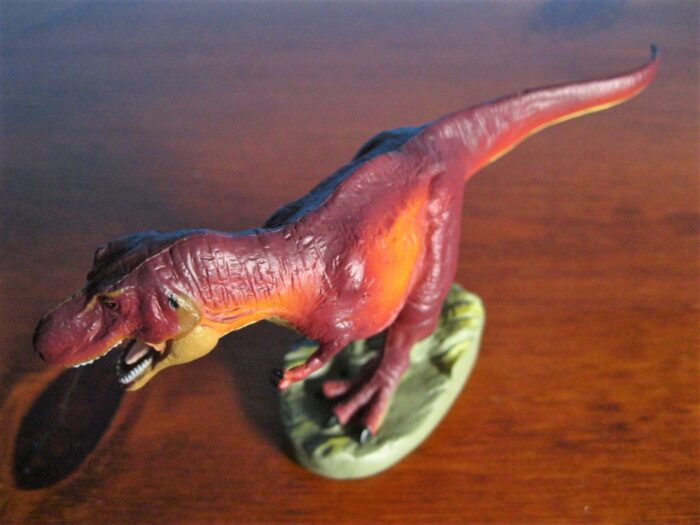
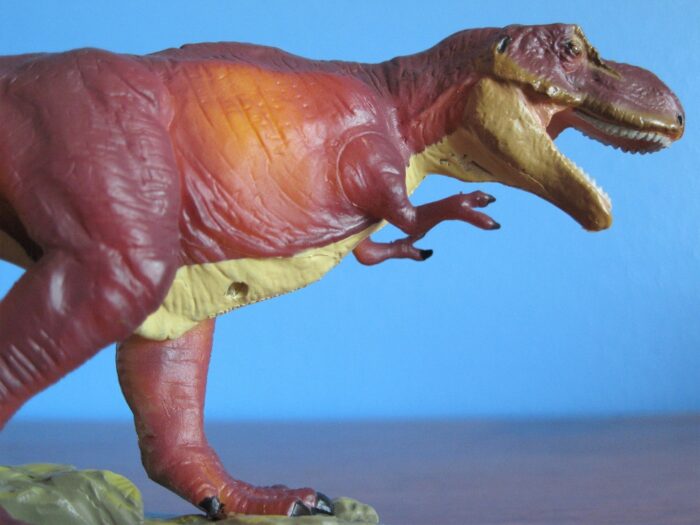
Figure #2 is Triceratops horridus, which fares less well than the ‘Rex’. The overall build of the figure looks somewhat blocky, lacking a neck almost entirely. Shrink wrapping is avoided, but the trike’s midsection looks oddly gaunt. Osteoderms or large scales are absent from the animal’s back, and the primary horns curve in a nondescript manner. The figure is granted another pleasing color scheme, however: multi-tone spotted blue/black patterns across the body. Some peach freckling on the frill is also present.
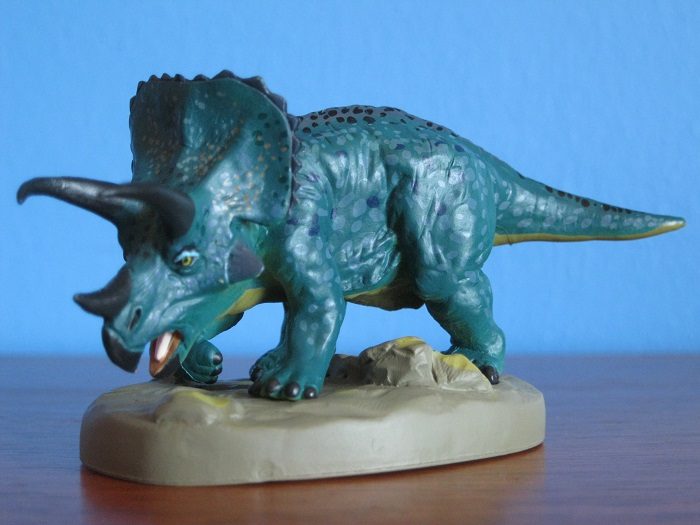
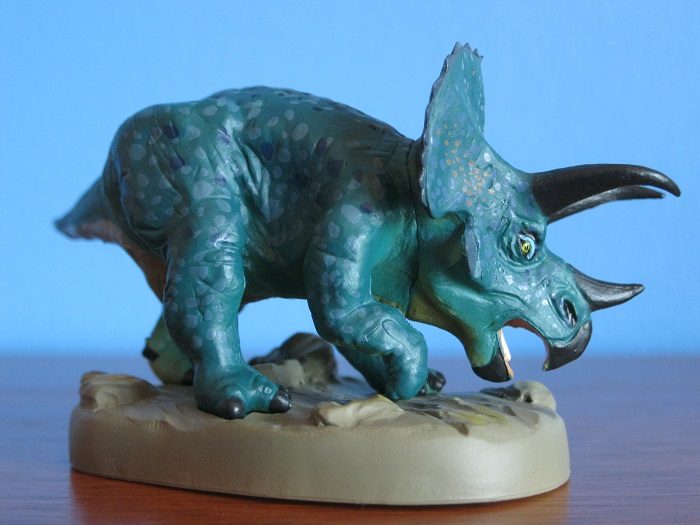
Figure #3 is Velociraptor mongoliensis, posed dynamically mid-pounce. Apart from the obvious lack of feathers, anatomical accuracy appears strong again, featuring a very sleek, lightweight predator. There is a bend halfway down the tail which would be physically impossible due to the rigidity of the tail. This particular color scheme – a high-contrast grassland-tone pattern – appears to be lifted from David Peters’ work for the book Raptors! The Nastiest Dinosaurs. It’s an excellent look for the dinosaur, reminiscent of desert & grassland predators today.
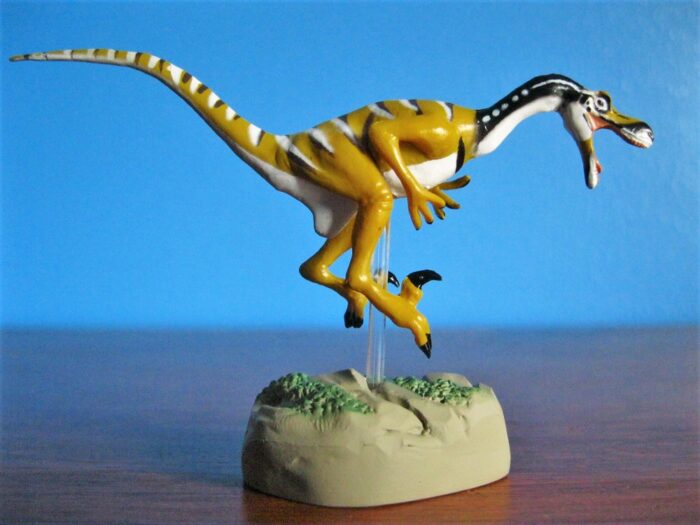
Figure #4 is Protoceratops andrewsi, which might actually be my favorite figure of the set. Although lacking the raised tail vertebrae, this figure is otherwise another solidly accurate-looking figure, with a surprising level of grace in pose and sculpt. The color scheme with red striping is eye-catching but not excessive, with particularly good detailing to the frill. The P. andrewsi is a more modest, but nonetheless impressive figure of the set.
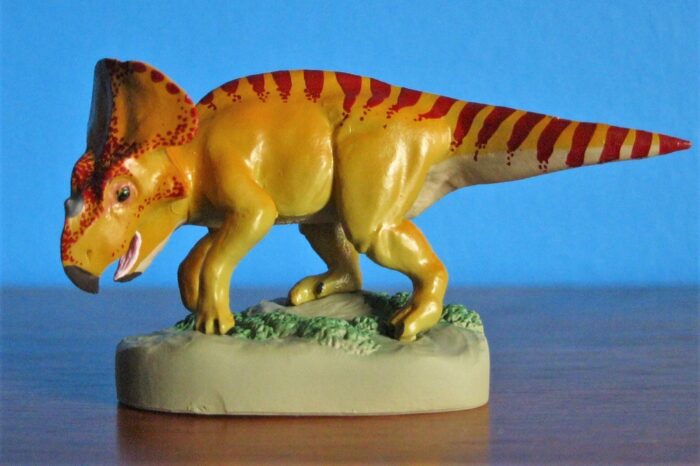
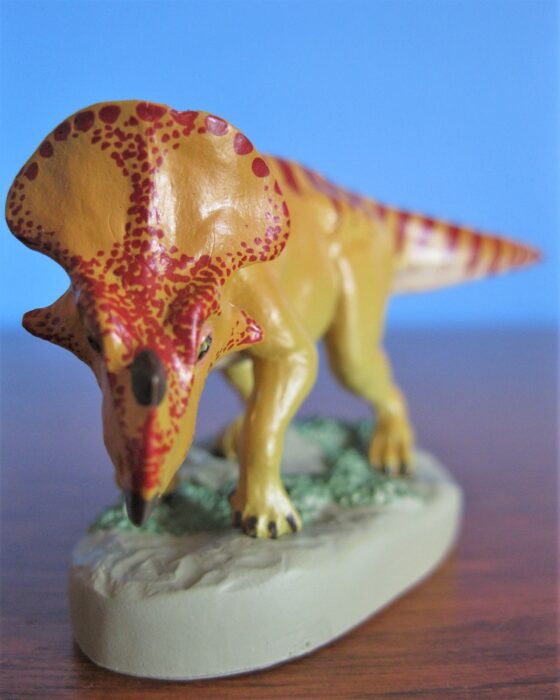
Figure #5 is Gallimimus bullatus. Although conspicuously unfeathered, like the Velociraptor, Galli looks otherwise accurate, though less precisely so. If anything the head is a bit large and nondescript. Its racing stripes color pattern resembles skinks and snakes, with tones similar (again) to the raptor before. Galli is ultimately perhaps the most reptilian-looking figure of the set, which is ironic for such a bird-like animal.
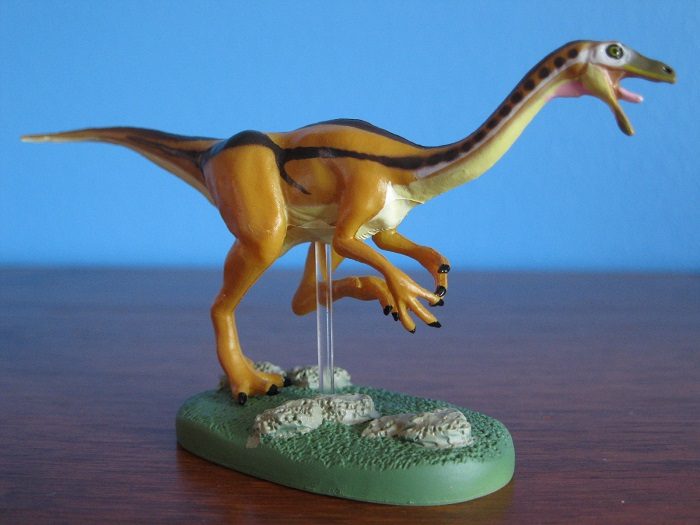
Figure #6 is the first pterosaur of the set, Quetzalcoatlus northropi. Quetzalcoatlus is one of the more striking figures of the set, with its long bill and great wingspan. As far as anatomical accuracy, it’s hard to judge when the species is so incompletely known; but generally speaking, it’s consistent with knowledge of the smaller Quetzalcoatlus sp., besides a less-ridiculously long neck and a reverse-shaped head crest. The given takeoff position might have been awkward for the real-life creature. It’s worth noting that the base seems to indicate an ocean-side dwelling, and the Quetzal’s coloration invokes an albatross or other large seabird. This depiction of azhdarchid pterosaurs is fairly out-of-date by now.
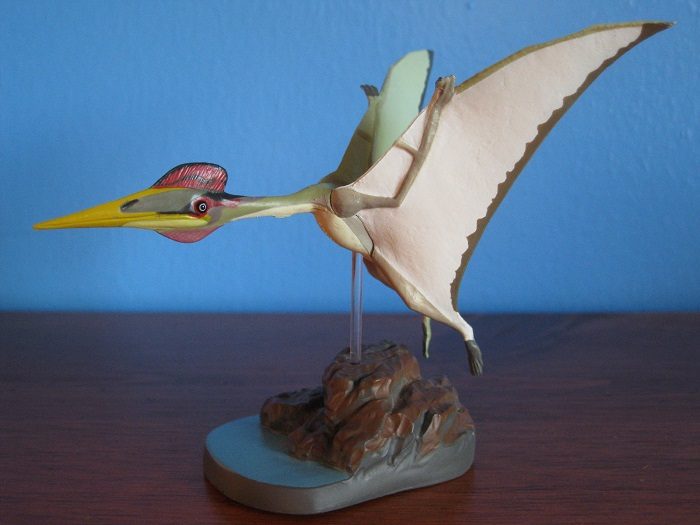
Figure #7 is Dsungaripterus weii, posed gracefully in flight over a seaside cliff. The ocean theme for the pterosaur bases is questionable, but the figure itself is nicely rendered with black and brown mottling across the wings and belly, with attractive red striping on the bill. Overall, it’s a color scheme that looks more appropriate for the inland creature Dsungaripterus is thought to be.
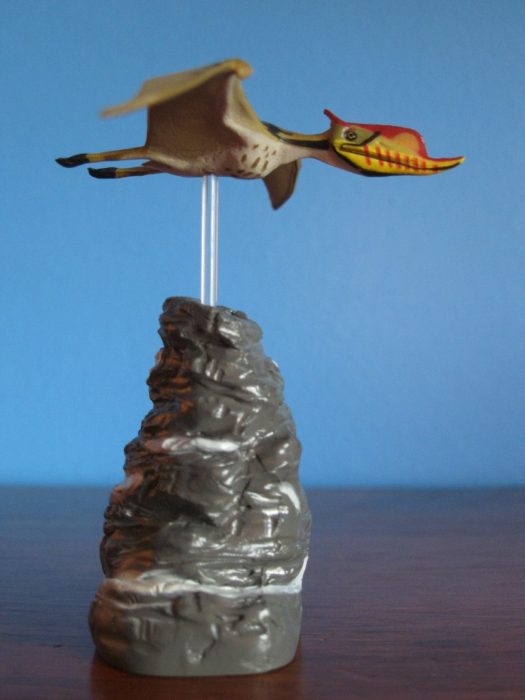
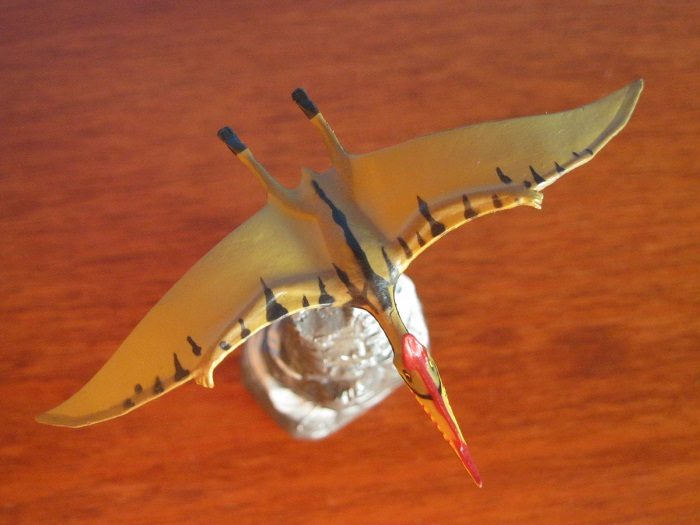
Figure #8, the last figure in the set, is Pteranodon ingens. Unlike the other figures in the set, Pteranodon comes fused to the base – again modeled in a seaside/rocky shore style. In Pteranodon‘s case, this is appropriate based on fossil evidence. The figure’s head, regrettably, lacks the curvature known from the animal’s bill and crest, but the rest of the body looks good, posed in an upright quadruped stance. The color scheme follows the brown and white with red/yellow/black highlights seen in Dsungaripterus and the coelurosaurs earlier, this time with a bright red head and yellow bill/crest.
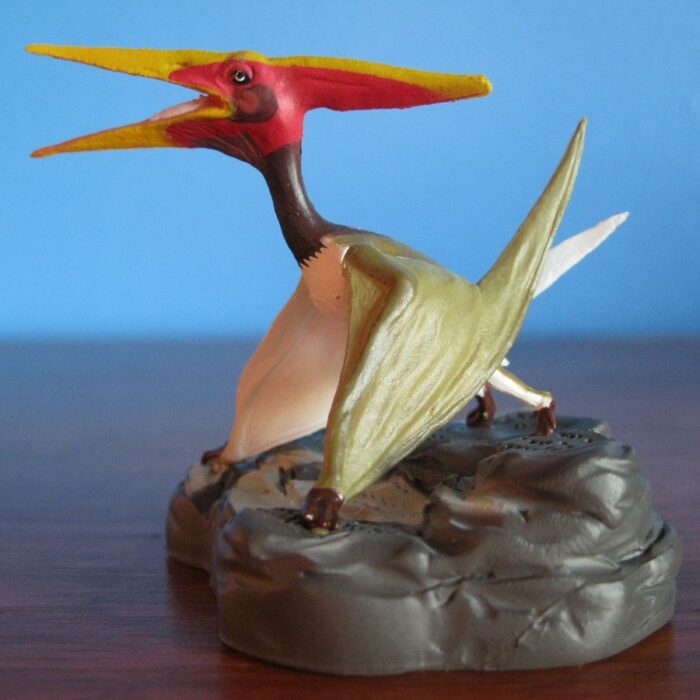
Colorata’s first dinosaur (and pterosaur) set doesn’t hold up perfectly to modern scientific understanding, but overall these are nicely made figures that should be good for both play and display. If you don’t want to buy directly from Colorata’s website, you can try finding it on eBay, but beware of the fluctuating prices. I got mine for about $40, and that’s the maximum one should have to pay.
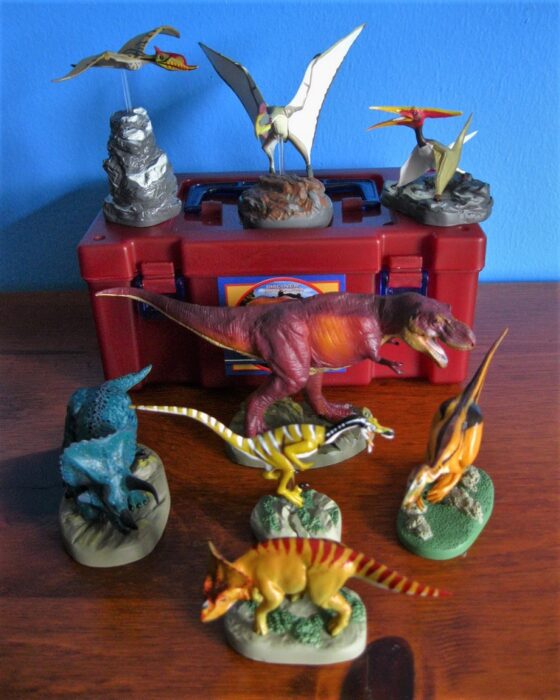
Disclaimer: links to Ebay and Amazon on the DinoToyBlog are affiliate links, so we make a small commission if you use them. Thanks for supporting us!




“The figure’s head, regrettably, lacks the curvature known from the animal’s bill and crest…”
I find this funny to read now, considering the bill controversy I ended up covering a couple of years later for the new Safari Pteranodon. Truly, few things stay constant in this field!
I’m just popping in to note that I discovered Colorata’s Quetz bears a striking resemblance to a painting by Todd Marshall (you can see it on his website). It’s not a total ripoff, but the inspiration for the pose is quite evident.
That’s a pretty decent selection of pterosaurs!
It is nice to see a mix of famous and quite obscure dinosaur species in this set! I prefer both the feathered dinosaur set and this one.
High time this set got a review!